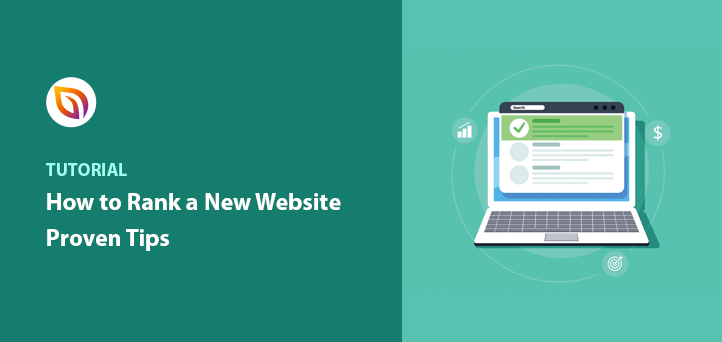Do you want to learn how to rank a new website in 2025? Not sure which strategies work the best?
Optimizing your website for search results can be a long and difficult process, but there are plenty of things you can do to help out along the way.
In this article, we cover essential WordPress SEO for a new website, with proven tips to help you increase organic traffic and grow your business.
目次
- 1. Perform Keyword Research for Your New Website
- 2. Optimize Your New Website for Target Keywords
- 3. Increase Your Website Loading Speed: Improve Your Ranking Factors
- 4. Make Your Website Mobile-Friendly for Better SEO
- 5. Add HTTPS Security
- 6. How to Index a New Website Quickly
- 7. Set Up a Coming Soon Page for Better SEO
- 8. Create SEO Friendly Content to Generate Website Traffic
- 9. Boost Your Website's Ranking With Internal Linking
- 10. Increase Your Rankings with Backlinks
- 11. Fix Missing or Broken Links for Better SEO
- 12. Optimize Social Media for New Websites
- 13. Embed Social Feeds to Boost Website SEO
- 14. Use Schema to Rank in Rich Snippets
- 15. Optimize Your Site for Local SEO
- 16. Use Website Analytics to Improve SEO
Before we start, you might be wondering why you should rank your site in search engines.
Why You Should Rank Your Website in Search Engines
Ranking your website in Google and other search engines offers a major benefit: it’s the easiest way to get organic traffic. Organic traffic simply means people finding your website through search results after looking for specific keywords.
When your new website appears at the top of search results, people are much more likely to click on it. This means you get more organic traffic.
A study by Sistrix found that the first organic search result gets an average click-through rate (CTR) of 28.5%. This means almost 30% of people click on the very first website they see in the results.
Improving your website’s visibility in search engines is also an excellent way to:
- Generate more leads and sales from your target audience
- Increase your website’s visibility online
- Make your business look more trustworthy
- Reduce the cost of advertising
If you’re new to SEO (WordPress search engine optimization), ranking a new website can seem daunting. But don’t worry! By following these proven tips, you can quickly rank your new website and start boosting your business sales.
How to Rank a Website On Google Before You Launch
Before you launch your brand-new website, you need to make sure people can find it when searching for keywords related to your business, products, or services.
To do this, you need to optimize your website so that Google sees it as high-quality content and worth ranking near the top of search results. Essentially, this is what SEO is all about.
So, before you launch your website, follow these tips to rank your website on Google.
1. Perform Keyword Research for Your New Website
Keyword research is essential for SEO success. Start by figuring out which keywords you want your website to show up for in search results. These are called your “target keywords.”
Put yourself in your customer’s shoes: What words and phrases would they use to search for the products or services you offer?
For example, you might come up with “cat food” if you sell pet food or “web designer in Florida” if you’re running a local web design business.

Brainstorming keywords is a great starting point. But to really understand what people are typing into search engines, you need to analyze keyword popularity and search volume. This tells you how many people are searching for specific terms and how much competition there is.
Several tools can help you get this data. Google Keyword Planner is a good free option. Paid tools like SEMRush and Ahrefs, offer even more features to track your website’s performance in search.
You can check out this guide for help in performing keyword research for your new website.
2. Optimize Your New Website for Target Keywords
After finding the best keywords to represent your business, the next step is to optimize your website around those search terms.
You should optimize your website’s homepage around your general business keyword, product pages around product or service keywords, and so on. This will help Google understand what each page is about and which keywords to rank them for.
Let’s look at a few methods for optimizing your website with your chosen keywords.
Optimizing Your Headings for SEO
Headings provide structure to your website content, making it easier for both people and search engines like Google to read.

Think of your headings like an outline:
- Use a single H1 heading for your main title.
- Organize the rest of your content with H2 and H3 subheadings.
- Include your target keyword in your H1 and use related keywords in your other headings where appropriate.
Optimize Your URLs for Better Rankings
Don’t forget to optimize your URLs. Each page on your website should have a unique URL that includes your target keyword and accurately reflects the page’s content.

Keep your URLs short, clear, and easy for both people and search engines to understand.
Write SEO-Friendly Content
Write content that is clear, engaging, and easy to read. Naturally incorporate your primary keyword throughout your text, but don’t overdo it.
Overusing keywords, known as “keyword stuffing,” can hurt your search rankings.
In fact, an SEMrush study found that over half of websites using keyword stuffing saw their rankings drop within six months. Instead, use synonyms and related phrases to create natural-sounding content that is enjoyable to read.
Try mentioning your target keyword early on in your content, ideally within the first paragraph.

Search engines can quickly understand what your page is about. Additionally, consider creating in-depth content (over 1,000 words) to provide more value and improve your chances of ranking higher.
Optimize Your Title Tags and Meta Descriptions
Your SEO title tag and meta description are like a storefront window for your web pages in search results. They should entice users to click and visit your site. The more clicks you get, the better your chances of ranking higher.
That’s why it’s crucial to write compelling title tags and meta descriptions that make people want to click.
Include your main keyword towards the beginning of your title tag to improve relevance. Aim for a length of 50-60 characters to prevent it from being cut off in search results.

Use your meta description to expand on your title and provide a concise summary of your page’s content. Incorporate your target keyword and include a clear call to action to encourage clicks.

You can also use All In One SEO, with its SEMRush integration, to find and add related keywords or additional keyphrases right within the WordPress editor.
You can see the search volume and trends right in the same window, eliminating the need for additional tools to research and decide what keywords to use.

For step-by-step instructions, see this guide on how to find related keywords in WordPress.
Optimize Your Image Alt Descriptions for SEO
High-quality images enhance your website’s visual appeal, but search engines need your help to understand them. That’s where alt text comes in.
Alt text is a short description that you add to the image’s HTML code. This tells search engines what the image depicts.
You can easily add your alt text in the WordPress block editor.
You can access your image by scrolling down in the post or page you’re editing and clicking on it so that it is marked with the blue frame. Then, go to the Image Settings in the right column of your editor, and type in your alt text in the Alt Text (alternative text) field.

Incorporate your primary keyword into both your image file names and alt text descriptions, but only if it feels natural and accurate. This helps search engines understand the context of your images and can potentially boost your rankings.
3. Increase Your Website Loading Speed: Improve Your Ranking Factors
Page speed is a crucial ranking factor. Search engines (and your visitors!) love websites that load quickly. A slow website can lead to lower conversion rates. Aim to make your new site fast, responsive, and secure.
Check Your Page Speed
To check your website’s loading speed, use a free website speed test tool like this one from IsItWP.

You’ll get a performance grade and helpful suggestions for speeding up your website.
Optimize Your Images for Faster Loading
Large image files can significantly slow down your website. Image compression reduces file size without sacrificing quality, resulting in faster loading times.
As a bonus, a faster website means visitors are less likely to leave out of frustration, improving your bounce rate.

To compress your images, you can use free services, such as:
- TinyPNG for PNG & JPG files
- CompressJPEG for JPG files
- Optimizilla for PNG & JPG files
This can reduce your image file size by 70% and more, which will have a huge impact on your site speed.
You can even use WordPress plugins like Imagify and WP Smush to optimize images right inside your WordPress website.
Use Speed Optimized Plugins and Themes
While WordPress offers countless plugins and themes, it’s important to choose wisely. Feature-packed options can be tempting, but they often come with bloated code that slows down your website.
Prioritize lightweight WordPress plugins that offer the essential features you need without unnecessary extras.
Consider self-hosted solutions for essential features. These powerful tools operate independently, minimizing the impact on your website’s speed and performance, even during traffic surges.
The same is true for your WordPress theme. Choose a WordPress theme that prioritizes speed and clean code. Look for themes advertised as “lightweight” or “optimized for SEO.” These options offer a balance of design, functionality, and fast loading times.

SeedProd, for example, is a powerful WordPress theme builder plugin that lets you create responsive website layouts without writing code or hiring a developer. You can use this plugin to create fast, engaging WordPress themes and high-converting landing pages in its visual drag-and-drop editor.
Because SeedProd centers on speed and functionality, it won’t slow down your website. Its code is fully optimized using the best WordPress practices, and the visual editor only includes the features you need to create a successful website.
Install a Cache Plugin for Better Website Speed
Installing a cache plugin can significantly improve your website’s speed. Cache plugins work by storing a copy of your web pages on your visitors’ browsers, so the page loads much faster the next time they visit.

For example, WP Rocket offers a comprehensive set of tools to help speed up your website, such as page caching and preloading. You can also use other cache plugins, such as WP Optimize or WP Fastest Cache.
Use a Content Delivery Network (CDN)
For even faster loading times, consider using a Content Delivery Network (CDN). A CDN stores cached copies of your website on servers located around the world. When someone visits your site, the CDN delivers content from the server closest to them, reducing loading times.
This will help speed up your website because it limits the number of internet hops it takes to display your content from your original server (your web hosting provider).
To learn more about CDN and how to connect your site, you can check out this guide on how to install and set up WordPress CDN.
4. Make Your Website Mobile-Friendly for Better SEO
Google uses “mobile-first indexing,” which means it primarily considers your website’s mobile version to determine your search rankings.
Therefore, it’s essential to make sure your website is mobile-friendly and responsive. This means it should look and function seamlessly on all devices, from desktops to smartphones and tablets.
You can check out Google’s Mobile-Friendly Test to see how your site performs on mobile devices.
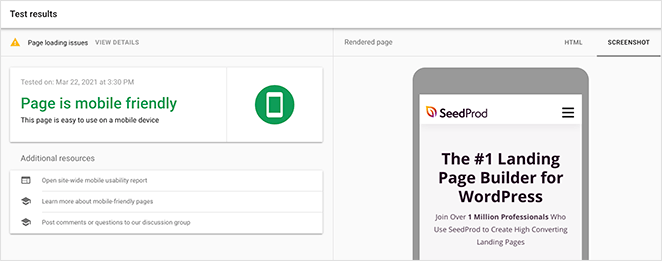
And if your new website isn’t mobile-friendly, it’s relatively easy to fix it.
First off, you can install a mobile-friendly WordPress theme. Most modern WordPress themes are mobile responsive right out of the box, so there isn’t much work involved.
A WordPress landing page builder like SeedProd can make this process even easier. SeedProd provides responsive templates and a drag-and-drop editor to create mobile-friendly landing pages and themes. Plus, you can preview how your designs will look on different devices before publishing.
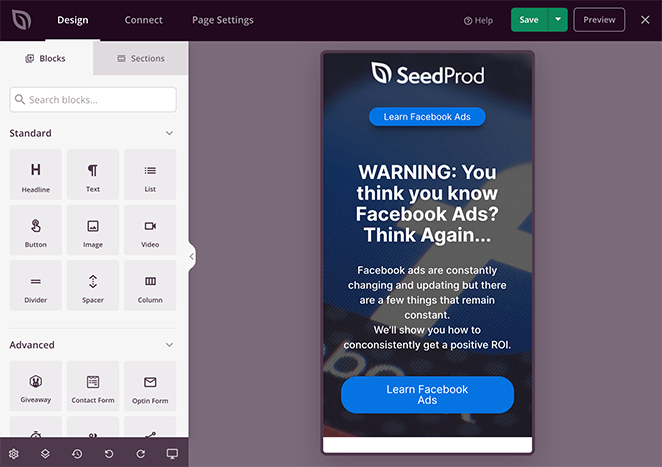
5. Add HTTPS Security
Website security is a top priority for both search engines and users. Google considers HTTPS as a ranking factor, and visitors feel more confident browsing and purchasing from secure websites.
Make sure your website has an HTTPS connection. HTTPS utilizes SSL encryption to secure the connection between your site and your visitors’ browsers.
The information that passes through is private and encrypted, so hackers can’t steal sensitive information like credit card details and passwords.
If you haven’t already done so, you can learn how to add SSL to your WordPress site here.
6. How to Index a New Website Quickly
After optimizing your website for your target keywords, speed, and security, you need to make it easy for Google to find and rank your new website.
One of the easiest ways to do this is to submit your website to individual search engines like Google, Bing, Yahoo, etc. Each search engine is different, so for now, let’s focus on how to index a new website with Google.
Set Up Google Search Console
Google Search Console is a free tool that helps website owners monitor and manage their site’s presence in Google search results. To submit your new website to Google, you’ll need to sign up for an account.
Signing up is free and easy. Go to the Google Search Console website and click the Start now button.
You can use your existing Google account to sign in or create a new account.
Next, Google asks you to enter your website domain name. We recommend using the URL prefix option here as it’s easier to verify.

After choosing this option, use the HTML tag method to verify your website and submit it to Google. Just click on the HTML tag option to expand it, and copy the code by clicking the Copy button.

There are many ways to add this code to your website, but today we’ll show you how to do it with a tool we’ve already mentioned in this article – the All In One SEO WordPress plugin.
First, install and activate the All in One SEO plugin. To learn how to do this, see this step-by-step guide on how to install a WordPress plugin.
Next, visit the All in One SEO » General Settings » Webmaster Tools and click on the Google Search Console option.

After that, paste the content value from your HTML meta tag into the Google Verification Code box. The part you want is the long string of numbers and letters.

Don’t forget to click the Save Changes button at the top of the screen.
Optimize Your New Website Architecture
Your website’s architecture refers to how your pages and content are organized. A clear and logical site structure makes it easier for search engines to crawl and index your website, improving your chances of ranking well.
If your pages aren’t linked well or are buried deep within your site, Google might miss them during crawling and indexing.
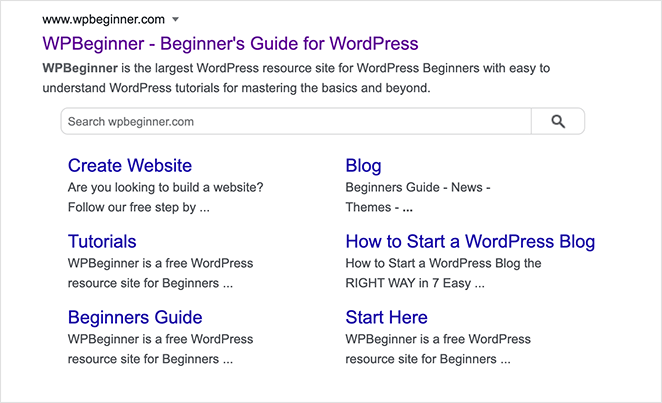
To avoid this, keep your site structure simple and ensure every page is no more than 3 clicks away from your homepage. You should also make sure there is a link pointing internally to and from each page.
Create an XML Sitemap for Your New Website
An XML sitemap is a list of every URL on your site that helps Google find and crawl your new website.
You can easily create an XML sitemap and send it to all popular search engines with All In One SEO. In fact, once you’ve installed and activated All In One SEO, it automatically generates a sitemap for you.
All you need to do is check if it’s enabled by navigating to All in One SEO menu » Sitemaps and clicking the General Sitemap tab.

This opens the General Sitemap window, where you can see that the Enable Sitemap option is set to on.

For video content, create a video sitemap to help Google find and index your videos. If you have a news website, a news sitemap will help you automatically submit your articles to Google News.
7. Set Up a Coming Soon Page for Better SEO
Another way to give your website a head start in Google rankings is to set up a coming soon page.
A coming soon page is a type of landing page you can add to your website to tell users your new site is on the way. It allows you to hide your site’s design process from the public while still helping you spread the news and generate excitement.

One of the best things about a coming soon page is it allows you to rank your new website in search engines before you launch. Since Google bots can crawl your coming soon page, they can index it in search results.
This means you can drive traffic to your new site from day 1!
The easiest way to set up a coming soon page in WordPress is with SeedProd. It has coming soon, and maintenance mode page modes built right into the plugin.
With a variety of mobile-responsive coming soon page templates, you can get started quickly. Plus, every template is fully customizable in the drag-and-drop builder, so you won’t need a developer.

SeedProd comes with easy-to-use landing page blocks designed to generate leads for your business, including:
- Eメールアドレスを収集するためのオプトインフォーム
- Countdown timers to create urgency and excitement
- Social media sharing and profile buttons to increase your followers
- Testimonial and star rating blocks for social proof
- Add-to-cart buttons for your WooCommerce store
- 他にもいろいろある。
As we mentioned earlier, SeedProd is lightning-fast and bloat-free, so it won’t impact your website’s performance.
You can follow this step-by-step guide to learn how to create a coming soon page in WordPress with SeedProd.
How to Rank a New Website After Launch: Proven Strategies
So far, we’ve looked at several ways to rank a new website before your launch. But there’s still plenty you can do to increase your rankings after launch day.
Follow the tips below to learn the best way to rank a new website after you launch.
8. Create SEO Friendly Content to Generate Website Traffic
Creating high-quality content is crucial for website traffic generation. You can do this by writing blog posts around keywords you know your target audience is searching for.
Use keyword research tools to find popular keywords within your niche. Focus on long-tail keywords (longer, more specific phrases). These often have less competition, making it easier to rank higher quickly.
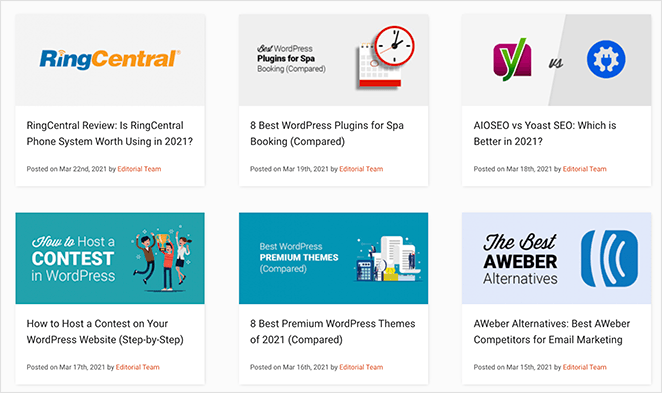
After finding some great topics with good search volume, follow these suggestions to write the best content for your new website:
- Create long, in-depth content. Long-form content generally performs better in search results.
- Use your target keywords, synonyms, and variations throughout your content.
- Optimize your meta tags (title, description, image alt).
- Use subheadings, bullet points, and short paragraphs.
- Always ensure you offer valuable information.
High-quality content naturally creates opportunities to link to other relevant pages on your website, which brings us to the importance of internal linking.
9. Boost Your Website’s Ranking With Internal Linking
We mentioned earlier that linking internally to relevant content on your website is an easy way for search engines to crawl and index your site. It can also help Google discover new content after it’s published.

There are 2 main methods for building good internal links on your new website, including:
- Always add relevant internal links to your content when you publish something new.
- Update your older content to add links to newer content regularly.
This will help your readers and Google discover how all your content is related.
Instead of manually searching for relevant posts to link to, you can use All in One SEO’s Link Assistant to easily find new linking opportunities.

This tool will automatically generate a link report for your site and provide link suggestions that you can apply to your content in 1-click.
10. Increase Your Rankings with Backlinks
Besides internal linking, backlinks are crucial website ranking factors. A study by Backlinko found that the top 10 results in Google across over 1 million keywords had an average of 52 backlinks each.
Also known as backlinks, they tell Google that your website is credible and worth ranking. So, you’ll need a good backlinking strategy to increase your website domain authority authority and rank.
Increase Backlinks by Guest Blogging
One of the most effective ways to generate quality backlinks is to guest blog on other websites. Guest blogging works because you offer value to site owners in exchange for a link back to your website.
If you choose your guest blogging targets carefully, you can soon build diverse and authoritative inbound links.
To guest blog effectively, you need to:
- Find sites that accept guest posts
- Pitch and create high-quality content
- Create an author bio that links to your website
Check out this ultimate guide to guest blogging for more helpful tips.
Drive Backlinks by Commenting
Engage in relevant online communities and leave thoughtful comments on other blogs in your industry to build relationships and potentially earn backlinks. But avoid spam commenting, as it can damage your reputation.
Instead, take the time to research blog posts and online discussions relevant to your industry. Then, write a detailed response that adds value to the conversation.
Some popular places for promoting your content and achieving backlinks include:
- クオラ
- レッドディット
- Facebook Groups
11. Fix Missing or Broken Links for Better SEO
Over time, as your website grows, you might accumulate broken links (links that lead to non-existent pages). While seemingly minor, broken links can negatively affect your SEO if left unaddressed.
Search engines can’t crawl broken links, preventing those pages from being indexed and appearing in search results.
Luckily you can solve this easily by redirecting broken links to the correct URL or a relevant piece of content.
Broken links also frustrate visitors, leading them to leave your site immediately. This increases your bounce rates, a metric that search engines consider when determining your rankings.
With this in mind, it’s good practice to have a 404 page in place. With a custom 404 page, you can redirect visitors about to leave to other pages on your website.

SeedProd is the best plugin for creating custom 404 page landing pages in WordPress. In fact, it has a 404 page mode ready-to-go right out of the box.
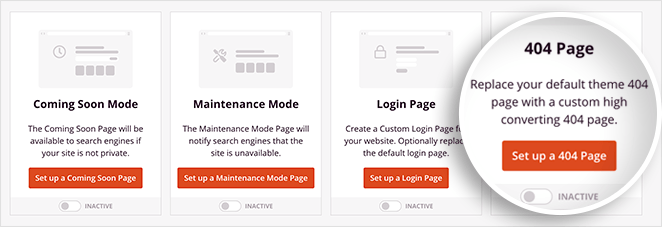
You can choose from various pre-made 404 landing page templates and customize them in the visual editor. Then, you can add page elements designed to keep visitors on your site for longer, such as relevant products, recent blog posts, and more.

You can even convert those visitors into leads by asking them to subscribe to your newsletter.
12. Optimize Social Media for New Websites
Optimizing your social media is important because it can strengthen your brand. It can increase your visibility and generate more leads for your business. Plus, the more your content is shared on social media, the more people will see it and link to it, resulting in increased backlinks.
More importantly, promoting your social media networks can help you get more visibility in search. For instance, optimized social media profiles can appear on the first page for branded searches (e.g., searching for your company name). This helps users find your official accounts easily.
The easiest way to tell search engines about your social media profiles is by entering your profile links in your SEO plugin.
All In One SEO lets you connect up to 11 Social Profiles to let Google know which are associated with your website:
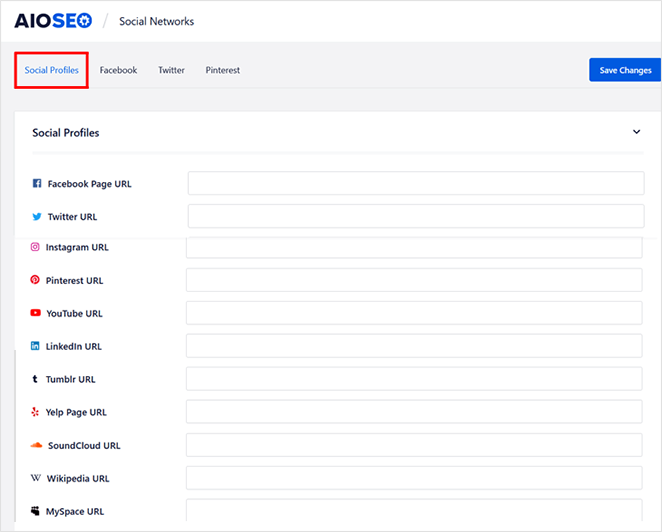
Just paste your profile links, and All In One SEO will take care of the rest.
13. Embed Social Feeds to Boost Website SEO
Considering that social media profiles rank so high in search results, they can help your new site rank higher if you add social media feeds to your website.
Instead of adding a plain social media button, you can embed your entire social media feed on your WordPress site using a social media feed plugin like Smash Balloon.
Smash Balloon lets you create completely customizable social media feeds tailored to your website.

Unlike regular social media plugins, Smash Balloon adds dynamic, indexed, and search engine crawlable content to your site. This will help boost your new website’s rankings even further.
14. Use Schema to Rank in Rich Snippets
No doubt you’ve seen those eye-catching search results on Google with star ratings and prices or questions and answers.
They’re called rich snippets, and they can help you achieve the highest rankings and traffic for your new website. They’re an easy way to add extra information about your business in search results.
Here’s an example of a rich snippet for recipes:

As you can see, they show information like star ratings, cooking time, and ingredients right inside the search results. This makes your content more noticeable, making it more likely to drive organic traffic to your site and increase sales.
One of the advantages of rich snippets is that you can often see results very quickly, sometimes in under 30 minutes. This is unlike many other SEO changes, which can take longer to have an impact.
Google rich snippets are created by adding schema markup or structured data to your web pages. You can easily add schema markup to your pages using All In One SEO.
For more details, check out their guide on how to add rich snippets to WordPress.
15. Optimize Your Site for Local SEO
For any business that serves customers in a specific location and wants to rank a new website, it’s important to optimize your website for local SEO. This will help local customers find your brick-and-mortar stores or local services.
You can start by creating a Business Profile in Google My Business.
A Google My Business profile is important for SEO because it makes you more visible in local search and Google Maps, where potential customers can easily find you.
You’ll have your own profile, and you can add your business’s information, photos, and showcase reviews straight from the search results.

This makes it easy for people to find your physical locations and puts your company at the top of the results. But to increase your chances of getting featured in Google’s Knowledge Panel, you need to add Google’s local business structured data or schema markup to your website.
With AIl In One SEO’s Local Business SEO addon, you can easily set this up and start increasing your rankings in the local search results, Google Maps, and the Knowledge panel in no time.
16. Use Website Analytics to Improve SEO
After following the tips above to rank your new website in search results, you’ll need to track your SEO efforts. By connecting your website to an analytics tool, you can measure your new website’s performance and see which SEO strategies deliver the best results.
The easiest way to track your website analytics is with Google Analytics.
It allows you to monitor:
- Who visits your website
- When people visit your website
- How people find your website
- What people do on your website
- How people interact with your content
After creating a Google Analytics account, the easiest way to set up Google Analytics on your website, especially if you use WordPress, is with MonsterInsights.

MonsterInsights is the best Google Analytics plugin for WordPress. It makes linking your website to Google Analytics super-easy and doesn’t require hiring a developer.
Once it’s installed, you can see your analytics reports right inside your WordPress dashboard.
You can view analytics for:
- eCommerce, including WooCommerce, Easy Digital Downloads, MemberPress, and more.
- Outbound link tracking to see where your site sends visitors.
- File download tracking to see which files are getting the most downloads.
- Custom events tracking without writing any JavaScript.
- Affiliate link tracking for bloggers and affiliate marketers
- そしてもっと。
You can also use MonsterInsights’ Search Console report to see how your new website site ranks in Google’s search results.

Check out this step-by-step guide on how to add Google Analytics to WordPress.
これで完成だ!
You now know how to rank a new website fast. With the right SEO tactics, you’ll see your site climb up in Google’s search results in no time.
And in the end, this will translate to traffic, leads, and sales for your business.
Before you launch, make sure to consult our comprehensive new website launch checklist. You might also like this article on how to increase landing page conversions to boost your revenue further.
お読みいただきありがとうございました!ご質問やご意見がありましたら、お気軽にコメントをお寄せください。
また、YouTube、X(旧Twitter)、Facebookでも、ビジネスの発展に役立つコンテンツを配信しています。

